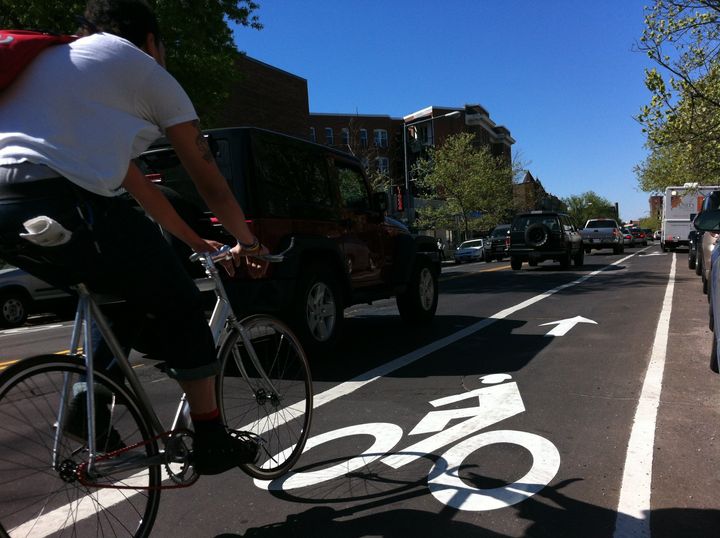
You can glimpse the future right now in forward-looking American cities -- a few blocks here, a mile there where people riding bicycles are protected from rushing cars and trucks.
Chicago's Kinzie Street, just north of downtown, offers a good picture of this transportation transformation. New bike lanes are marked with bright green paint and separated from motor traffic by a series of plastic posts. This means bicyclists glide through the busy area in the safety of their own space on the road. Pedestrians are thankful that bikes no longer seek refuge on the sidewalks, and many drivers appreciate the clear, orderly delineation about where bikes and cars belong.
"Most of all this is a safety project," notes Chicago's Transportation Commissioner Gabe Klein. "We saw bikes go up from a 22 percent share of traffic to 52 percent of traffic on the street with only a negligible change in motorists' time, but a drop in their speeds. That makes everyone safer."
Klein heralds this new style of bike lane as one way to improve urban mobility in an era of budget shortfalls. "They're dirt cheap to build compared to road projects."
Mayor Rahm Emanuel won election last year on the promise of building 100 miles of these "green lanes" over the next four years to heighten the city's appeal to new businesses.
People on bikes everywhere feel more safe and comfortable on busy streets with a physical barrier between them and motor vehicles. In some places it's a plastic post or line of parked cars. In others it's a curb, planter or slightly elevated bike lanes.
"We've seen biking almost triple on parts of 15th Street NW since installing a protected bike lane last year," reports Jim Sebastian, Active Transportation Project Manager for the District of Columbia. "And we're seeing different kinds of cyclists beyond the Lycra crowd. People in business suits, high heels, families out for a ride, more younger and older people."
"This is what cities of the future are doing to attract businesses and young people," notes Andy Clarke, president of the League of American Bicyclists. "People don't want to drive all the time; they want a choice."
The Green Lane Project, an initiative to showcase these next-generation transportation improvements, launched May 31 in six U.S. cities: Chicago, Washington D.C., Memphis, Austin, San Francisco and Portland, Oregon. The effort is coordinated by the Bikes Belong Foundation.
"The idea is to create the kind of bike networks that will attract the 60 percent of all Americans who say they would bike more if they felt safer," says Randy Neufeld, a longtime bike advocate in Chicago.
The proliferation of new bike sharing systems -- where people can conveniently rent bikes at on-street stations with a credit card -- creates new demand for green lanes by getting more riders on the streets. Bike share is now running full board in Washington, Denver, Boston, Minneapolis-St. Paul, Chattanooga and Miami Beach and coming soon to New York, Chicago, Los Angeles and many other cities.
The United States has witnessed a boom in bicycling over the past 15 years, proving that bikes aren't just for kids and recreational riders anymore. They are an essential component of 21st Century transportation systems that can cut congestion on crowded streets, save money in transportation budgets, improve traffic safety and reduce pollution.
The number of Americans commuting to work by bike has climbed about 40 percent since 2000, according to census figures. And numbers are even higher in places making their streets more accommodating for bicyclists. New York City, Boston, Seattle and Minneapolis-St. Paul have all more than doubled the number of people on bikes over the past five years.
Encouraging more people to ride bikes offers substantial rewards for all Americans, whether they ride a bike or not, by using streets more efficiently to move people and offering an economical choices in transportation as well as addressing looming problems such as the obesity epidemic and volatile fuel prices.
Of course, any proposal to reconfigure the streets -- even in modest ways -- can stir opposition. It's true that in some cases, carving out space for people on bikes means reducing parking spaces or travel lanes for cars. In other designs, parking and travel lanes stay the same.
A follow-up study tracking the 15th Street Green Lanes in Washington found that 78 percent of people living nearby view the project as a neighborhood amenity, even though most of them did not regularly ride a bike. And in New York City, protected bike lanes sparked a heated debate last year when politically well-connected figures lobbied to rip them out. But a slew of opinion polls showed that most city residents approved of the changes, and the lanes stayed.
The ultimate goal of the Green Lane Project is to make bicycling to work or shopping feel as normal as walking the dog.